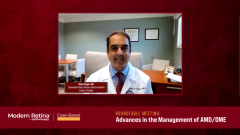
Impressions and Takeaway Points From Patient Case #1
A retina specialist discusses impressions and key takeaway points from the case of a 59-year-old male with DME.
Rishi Singh, MD: My initial impression of this case is this patient has really good vision in the left eye and not-so-good vision in the right eye. The history of noncompliance is concerning. Obviously, if you're trying to institute comprehensive therapy like anti-VEGF [vascular endothelial growth factor] therapy you need patient buy-in for the patient to come back and for you to have the ability to continually treat the patient over time. Certainly, I'm worried about that in this case. The challenge here is that this patient's treatment might require multiple injections and whether they'll be tolerant of those multiple injections. We have a lot of different drugs to pick from these days: Avastin [bevacizumab], ranibizumab, aflibercept, and even Vabysmo [faricimab-svoa] as well as faricimab. We have a many different options for therapy with this patient and really deciding when we institute this intravitreal therapy is of utmost importance.
Well, I think the goals are really the same as any patient we treat with anti-VEGF therapy, which is to dry the retina the most we possibly can because we know that retinal fluid is damaging to the retina and causes vision loss over time.
A variety of different drugs have been approved for diabetic macular edema, including faricimab, aflibercept, and ranibizumab. In clinical practice, we use whatever we think has the most potency and durability. In most of our patients, right now there are 2 camps: the patients we believe are the most durable are on aflibercept or those who are most durable potentially are now starting with faricimab. Faricimab is new to our practice. We've only had it for a week or 2, so we're learning how to use it in clinical practice.
Faricimab is a different agent than the other agents currently available for ophthalmology in that it has both angiopoietin 2 inhibition as well as VEGF suppression or inhibition. This combination works synergistically to reduce the potential treatment burden for patients and improve clinical outcomes. The agent is the first we've ever had in a bispecific format in our field.
What really stands out in the YOSEMITE [NCT03622580] and RHINE [NCT03622593] trials is the durability in the number of patients who are able to go 16 weeks or longer in the study. About 75% or 80% of patients can go 12 weeks or longer, and almost 30% to 40% of patients can go 16 weeks or longer. Really quite impressive numbers; probably the best numbers we've ever seen regarding durability, and it makes us consider using faricimab for a lot of our patients with diabetic macular edema.
What was exciting to me when I discussed this case with our faculty who were present at the program was they had differing opinions on how they might handle this patient. Some people were saying that the patient should get anti-VEGF therapy, which is on-label, versus some people saying off-label—which is really saying, just graduate to faricimab and treat the patient that way. I was intrigued by the diversity of the answers, and some of them have evidence surrounding them or evidence-based arguments surrounding them, so you could probably argue this in many different fashions.
Transcript Edited for Clarity
Newsletter
Keep your retina practice on the forefront—subscribe for expert analysis and emerging trends in retinal disease management.













































